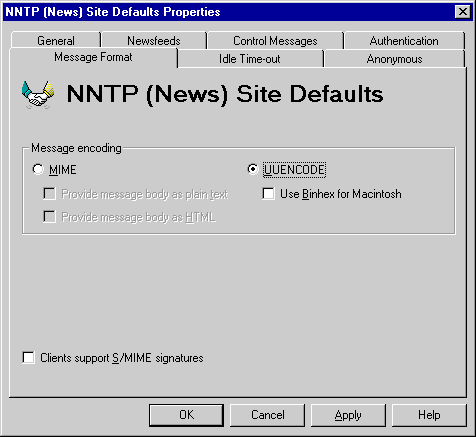
| Operations | << | >> |
|---|
You can specify the message format for encoding newsgroup items from the NNTP site object or the NNTP server object. This applies to both incoming and outgoing messages.
The settings in the Message Format property page determine the format that Microsoft Exchange Server messages are converted to when they are retrieved by an NNTP client. Messages sent by an Internet user are not converted. Instead they are retrieved by the NNTP client in the format that the message was originally composed in.
Note Default character settings for NNTP are configured on a per-folder basis. For more information, see "Setting Properties on Newsgroup Public Folders" later in this chapter.

When a user retrieves messages using NNTP, you can specify how these messages are converted from the Microsoft Exchange Server format to various Internet mail formats.
| Option | Description |
|---|---|
| MIME | Text and attachments are encoded using Multipurpose Internet Mail Extensions (MIME). MIME is the standard for exchanging multimedia messages on the Internet. If a MIME message is delivered to a non-MIME-aware client, the text and attachments may not be usable. This is the default. |
| Send message body as plain text | A plain text MIME body part is generated for the message. If Send message body as HTML is also selected, a MIME multipart alternative plain text MIME body part is generated. |
| Send message body as HTML | An HTML MIME body part is generated for the message. If Send message body as plain text is also selected, a MIME multipart alternative HTML MIME body part is generated. HTML is an Internet standard that enables rich-text formatting, such as bold, color, and italic, to appear in messages. Clients such as Microsoft Internet Mail and News version 3.0 can read HTML. |
| UUENCODE | Renders the message body as text with any attachments encoded by the uuencode method, which is commonly used in the UNIX operating system to encode 8-bit data transmitted on the Internet. |
| Use Binhex for Macintosh | Renders the message body as text with any attachments encoded by the BinHex method, a common method used in the Macintosh operating system to encode 8-bit data transmitted on the Internet. |
You can use the Message Format property page to enable support for signed S/MIME messages. This is useful for accessing newsgroups that contain signed S/MIME messages.